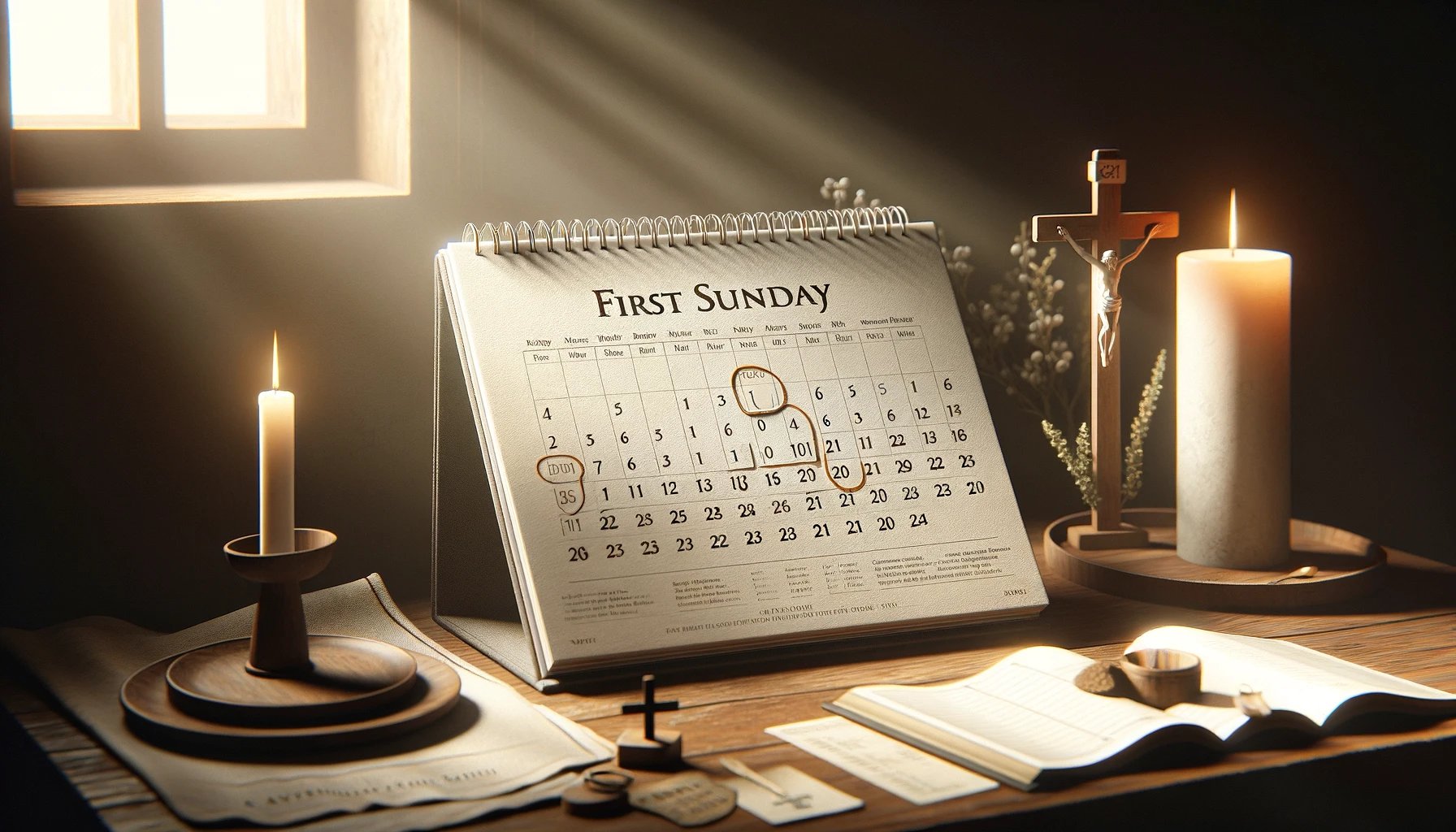Home>Special Themes>When Is The First Sunday In Advent


Special Themes
When Is The First Sunday In Advent
Published: February 14, 2024
Peter Smith, Editorial Director at Christian.net, combines deep insights into faith, politics, and culture to lead content creation that resonates widely. Awarded for his contributions to religious discourse, he previously headed a major organization for religious communicators, enhancing dialogue on faith's societal impacts.
Discover the significance of the first Sunday in Advent and its special themes. Learn about the traditions and customs associated with this important day. Find inspiration for celebrating the start of the Advent season.
(Many of the links in this article redirect to a specific reviewed product. Your purchase of these products through affiliate links helps to generate commission for Christian.net, at no extra cost. Learn more)
Table of Contents
Introduction
Advent, a time of anticipation and preparation, holds a significant place in the Christian calendar. As the world transitions into the winter season, the arrival of Advent marks the commencement of a period filled with hope, reflection, and joy. This sacred time, observed by various Christian denominations, serves as a spiritual journey leading up to the celebration of the birth of Jesus Christ on Christmas Day.
The word "Advent" originates from the Latin word "adventus," meaning "coming" or "arrival." It symbolizes the anticipation of the arrival of Jesus Christ, both in the form of the historical nativity and the future second coming. This period is not only a time of spiritual readiness but also a reminder of the profound significance of Christ's birth and the promise of his return.
During Advent, believers are encouraged to reflect on the themes of hope, peace, joy, and love, which are represented by the four candles of the Advent wreath. Each candle, lit on successive Sundays leading up to Christmas, symbolizes the increasing light that Christ brings into the world. This tradition fosters a sense of unity and spiritual connectedness among the faithful, as they collectively prepare their hearts to welcome the birth of Jesus.
The observance of Advent is not merely a historical or religious custom; it is a time-honored tradition that transcends generations, uniting families and communities in a shared sense of faith and devotion. Through the centuries, the essence of Advent has remained steadfast, serving as a beacon of hope and renewal for believers around the world.
As we delve deeper into the history, significance, and customs of Advent, we will uncover the rich tapestry of traditions that have evolved over time, each contributing to the profound depth of meaning associated with this sacred season. Join us on this enlightening journey as we explore the timeless allure of Advent and the enduring impact it continues to have on the hearts and minds of millions.
Read more: What Is The First Advent Sunday
The History of Advent
The history of Advent can be traced back to the early centuries of Christianity, with its origins rooted in the practices of the Western Church. The exact emergence of Advent as a distinct liturgical season is not precisely documented, but its development can be attributed to a convergence of historical, cultural, and religious influences.
The earliest records of Advent date back to the 4th and 5th centuries, when the church fathers began to emphasize the importance of spiritual preparation leading up to the celebration of Christ's birth. During this period, the observance of Advent varied among different Christian communities, with some focusing on fasting and penance, while others emphasized joyful anticipation and spiritual reflection.
The Council of Tours in 567 is credited with formalizing the observance of Advent, establishing a period of fasting and prayer in preparation for the feast of the Nativity. Over time, the duration of Advent evolved, with practices differing between the Eastern and Western Christian traditions. In the West, Advent typically spanned 40 days, mirroring the length of Lent, while the Eastern Church observed a shorter period of fasting and preparation.
The liturgical reforms of the Second Vatican Council in the 1960s brought about significant changes to the observance of Advent, refining its focus on the themes of hope, peace, joy, and love. This shift in emphasis aimed to align the spiritual significance of Advent with the evolving needs of the faithful in the modern era.
Throughout its history, Advent has undergone a process of refinement and adaptation, incorporating diverse cultural and regional customs while retaining its core emphasis on spiritual readiness and anticipation. Today, the observance of Advent continues to resonate with believers worldwide, serving as a timeless reminder of the profound significance of Christ's birth and the enduring promise of his return.
As we delve into the historical tapestry of Advent, we gain a deeper appreciation for the enduring legacy of this sacred season. Its evolution over the centuries reflects the dynamic interplay between tradition, faith, and cultural expression, underscoring the universal appeal and enduring relevance of Advent in the hearts and minds of believers across the globe.
The Meaning of Advent
Advent, a cherished season in the Christian calendar, embodies profound significance and multifaceted symbolism. At its core, Advent represents a period of spiritual preparation and anticipation, serving as a poignant reminder of the timeless themes of hope, peace, joy, and love.
The essence of Advent extends beyond mere countdown to Christmas; it encapsulates the broader narrative of salvation history. It beckons believers to embark on a transformative journey, both individually and collectively, as they prepare their hearts to welcome the birth of Jesus Christ. This period of introspection and spiritual contemplation fosters a sense of renewal and reawakening, inviting believers to embrace the profound message of redemption and grace.
The four candles of the Advent wreath, each representing a distinct theme, serve as poignant symbols of the spiritual journey unfolding during this sacred season. The first candle, symbolizing hope, ignites a sense of optimism and expectation, reminding believers of the enduring promise of Christ's coming. The second candle, representing peace, serves as a beacon of tranquility amidst the chaos of the world, offering solace and reassurance to those who seek inner harmony. The third candle, embodying joy, radiates a spirit of celebration and exuberance, heralding the imminent arrival of the Savior with unbridled delight. Finally, the fourth candle, epitomizing love, encapsulates the profound depth of God's unconditional love for humanity, underscoring the transformative power of divine compassion and empathy.
Advent transcends the boundaries of time and space, resonating with believers across generations and cultures. It unites the faithful in a shared sense of anticipation and reverence, fostering a collective spirit of unity and devotion. This season of spiritual introspection invites believers to pause amidst the hustle and bustle of daily life, to reflect on the profound mysteries of faith and the enduring promise of salvation.
As believers immerse themselves in the timeless traditions and customs of Advent, they are reminded of the enduring relevance of this sacred season. It serves as a poignant reminder of the enduring legacy of faith, hope, and love, weaving a tapestry of spiritual significance that continues to inspire and uplift hearts around the world.
In essence, the meaning of Advent transcends the boundaries of tradition and ritual; it embodies the timeless message of hope, peace, joy, and love, inviting believers to embark on a transformative journey of spiritual renewal and anticipation. As we embrace the profound significance of Advent, we are reminded of the enduring promise of Christ's coming and the timeless allure of the Christmas story.
The Date of the First Sunday in Advent
The date of the First Sunday in Advent holds a special place in the hearts of believers, marking the commencement of this sacred season of anticipation and spiritual preparation. This significant day, which varies each year, serves as a poignant reminder of the timeless themes of hope, peace, joy, and love that characterize the Advent season.
In the Western Christian tradition, the First Sunday in Advent falls on the Sunday closest to the feast of St. Andrew, which is celebrated on November 30th. As a result, the date of the First Sunday in Advent fluctuates between November 27th and December 3rd. This variability adds a sense of anticipation and unpredictability to the observance of Advent, underscoring the dynamic nature of this sacred season.
The fluidity of the date of the First Sunday in Advent is intricately linked to the liturgical calendar, which follows a cyclical pattern based on the date of Easter. The observance of Advent begins on the Sunday closest to the feast of St. Andrew, marking the start of a period of spiritual reflection and preparation that spans four weeks. This deliberate alignment with the feast of St. Andrew serves as a poignant reminder of the enduring legacy of the saints and their profound impact on the Christian faith.
The fluctuating date of the First Sunday in Advent adds a sense of anticipation and excitement to the onset of this sacred season. It invites believers to embark on a spiritual journey that unfolds against the backdrop of the winter season, infusing the observance of Advent with a sense of mystery and wonder. This variability also underscores the universal nature of Advent, transcending geographical and cultural boundaries to unite believers in a shared sense of anticipation and spiritual readiness.
As the First Sunday in Advent heralds the beginning of this sacred season, it serves as a poignant reminder of the enduring promise of Christ's coming and the timeless allure of the Christmas story. This date, steeped in tradition and symbolism, invites believers to embark on a transformative journey of spiritual renewal, fostering a sense of unity and devotion as they prepare their hearts to welcome the birth of Jesus Christ.
In essence, the date of the First Sunday in Advent encapsulates the dynamic interplay between tradition, faith, and anticipation, underscoring the enduring relevance of this sacred season in the hearts and minds of believers around the world. It serves as a poignant reminder of the profound significance of Advent, inviting believers to embrace the timeless themes of hope, peace, joy, and love as they embark on a spiritual pilgrimage leading up to the celebration of Christ's birth.
Traditions and Customs of Advent
The observance of Advent is steeped in rich traditions and customs that have evolved over centuries, weaving a tapestry of spiritual significance and cultural expression. These timeless practices serve as poignant reminders of the enduring legacy of faith, hope, and anticipation, uniting believers in a shared sense of reverence and devotion.
One of the most iconic symbols of Advent is the Advent wreath, a circular arrangement of evergreen foliage adorned with candles. Each candle holds profound symbolism, representing the themes of hope, peace, joy, and love. As believers gather around the Advent wreath, they light a new candle on each Sunday of Advent, fostering a sense of anticipation and spiritual reflection as they journey towards the celebration of Christ's birth.
Another cherished tradition is the Advent calendar, which traces its origins to 19th-century Germany. This interactive countdown to Christmas features a series of numbered doors or compartments, each concealing a small gift or treat. The Advent calendar serves as a delightful way for families and individuals to mark the passage of time during the Advent season, building excitement and anticipation as Christmas draws near.
In many Christian households, the observance of Advent extends beyond the walls of the church, permeating daily life with meaningful rituals and customs. Families often engage in Advent devotions and prayers, setting aside time each day to reflect on the profound significance of Christ's coming. This intentional focus on spiritual preparation fosters a sense of unity and reverence, strengthening familial bonds and nurturing a shared sense of faith.
The tradition of the Jesse Tree, rooted in biblical symbolism, offers a unique way to engage with the narrative of salvation history during Advent. Families decorate a tree with ornaments representing key figures and events from the Old Testament, tracing the lineage of Jesus Christ. This tradition serves as a powerful visual aid, connecting believers with the broader tapestry of God's redemptive plan and fostering a deeper appreciation for the rich heritage of faith.
Throughout the Advent season, believers also engage in acts of charity and compassion, embodying the spirit of giving and goodwill. Whether through volunteer work, donations to those in need, or acts of kindness towards others, the Advent season inspires a spirit of generosity and empathy, reflecting the timeless message of love and compassion exemplified by the birth of Jesus Christ.
In essence, the traditions and customs of Advent serve as a vibrant tapestry of faith, hope, and anticipation, weaving a narrative of spiritual significance that resonates across generations and cultures. These cherished practices unite believers in a shared journey of preparation and reflection, fostering a sense of unity and devotion as they prepare their hearts to welcome the birth of Jesus Christ.
Read more: What Is The First Sunday Of Advent
Conclusion
In conclusion, the observance of Advent stands as a timeless testament to the enduring legacy of faith, hope, and anticipation in the Christian tradition. This sacred season, marked by the themes of hope, peace, joy, and love, serves as a poignant reminder of the profound significance of Christ's birth and the enduring promise of his return. As believers embark on this spiritual journey of preparation and reflection, they are united in a shared sense of reverence and devotion, transcending geographical and cultural boundaries.
The rich tapestry of traditions and customs associated with Advent adds depth and meaning to the observance of this sacred season. From the iconic Advent wreath to the cherished practices of the Jesse Tree and the Advent calendar, each tradition serves as a poignant reminder of the enduring allure of the Christmas story. These customs not only foster a sense of anticipation and excitement but also provide opportunities for families and communities to come together in shared moments of spiritual reflection and unity.
The date of the First Sunday in Advent, with its variability and unpredictability, adds a sense of anticipation and mystery to the onset of this sacred season. This fluctuating date serves as a poignant reminder of the dynamic nature of Advent, inviting believers to embrace the journey of spiritual renewal and preparation amidst the winter season.
The history of Advent, rooted in the early centuries of Christianity, reflects the dynamic interplay between tradition, faith, and cultural expression. As this sacred season has evolved over time, it has retained its core emphasis on spiritual readiness and anticipation, resonating with believers across generations and cultures.
In essence, the observance of Advent transcends mere ritual and tradition; it embodies the timeless message of hope, peace, joy, and love, inviting believers to embark on a transformative journey of spiritual renewal and anticipation. As we immerse ourselves in the rich tapestry of Advent, we are reminded of the enduring promise of Christ's coming and the profound significance of the Christmas story.
As the world embraces the spirit of Advent, may this sacred season serve as a source of inspiration, unity, and renewal for believers around the globe. Through the timeless themes of hope, peace, joy, and love, may the observance of Advent continue to kindle the flame of faith in the hearts of all who seek spiritual nourishment and renewal.














